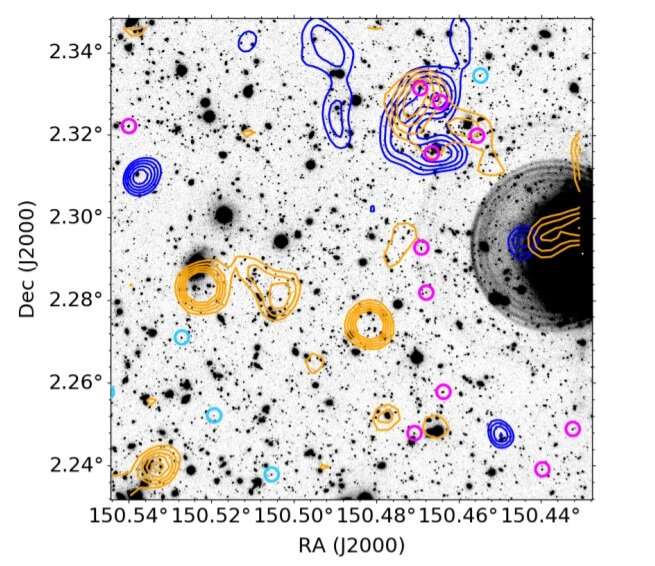UltraVISTA Ks-band image of G237. Credit: Poletta et al., 2021.
An international team of astronomers has performed spectroscopic observations of a distant galaxy protocluster known as PHz G237.01+42.50. Results of the study, presented in a paper published September 9 on the arXiv pre-print server, yield essential information regarding the properties of this protocluster.
Galaxy clusters contain from hundreds to thousands of galaxies bound together by gravity. They are the largest known gravitationally bound structures in the universe, which could serve as excellent laboratories for studying galaxy evolution and cosmology.
Astronomers are especially interested in studies of protoclusters of galaxies, the progenitors of clusters. Such objects, found at high redshifts (over 2.0), could provide essential information about the universe at its early stages.
At a redshift of approximately 2.16, PHz G237.01+42.50 (or G237 for short) is a galaxy protocluster detected with the Planck satellite. The object was first reported in the Planck high-z (PHz) sample, which contains more than 2,000 protocluster candidates at redshifts between 2.0 and 4.0. Previous observations of this protocluster show that it has a size of 12 by 5.5 arcminutes and its star formation rate is estimated to be between 10,100 and 18,200 solar masses per year.
A group of astronomers led by Maria Polletta of the Institute of Space Astrophysics and Cosmic Physics of Milano, Italy, has conducted spectroscopic observations of G237 in order to get more insights into the nature of this protocluster. For this purpose, they employed the LUCIFER spectrograph—Large Binocular Telescope Near-infrared Spectroscopic Utility with Camera and Integral Field Unit for Extragalactic Research.
The observations found that G237 contains an overdensity of 31 spectroscopically identified galaxies. Within this overdensity, two substructures were detected—designated ss1 (consisting of 20 galaxies) and ss2 (with 8 galaxies). Both substructures are expected to collapse and become clusters with halo masses of around 500–600 trillion solar masses.
The total star formation rate of the overdensity in G237 was estimated to be around 4,000 solar masses per year. The astronomers noted that although this value is higher than predicted by simulations, it is still much smaller than estimated by previous studies.
The research found that most members of the overdensity are normal star-forming galaxies (SFGs) with a wide range of stellar masses (between 2 and 200 billion solar masses). They turned out to be either disks or irregular galaxies with star formation rates consistent with the main sequence relation at their redshift. It was added that active galactic nuclei (AGN), represent a significant fraction (about 20 percent) of all members of the G237 protocluster.
The study also found that the core of G237, besides being denser, includes members that are, on average, more massive and star-forming and contains a larger fraction of AGN and dusty SFGs than the whole protocluster.
More information: M. Polletta et al, Spectroscopic observations of PHz G237.01+42.50: A galaxy protocluster at z=2.16 in the Cosmos field. arXiv:2109.04396v1 [astro-ph.GA], arxiv.org/abs/2109.04396
© 2021 Science X Network
























